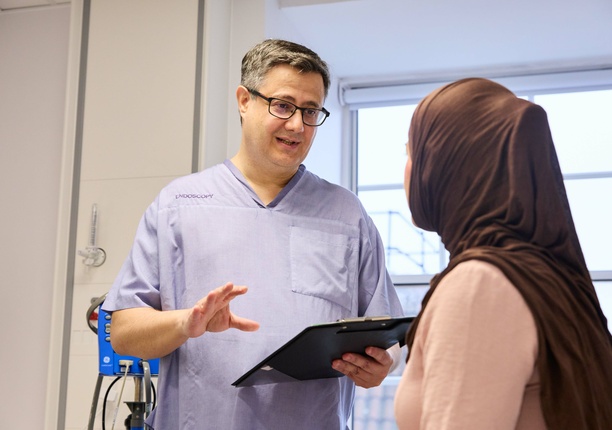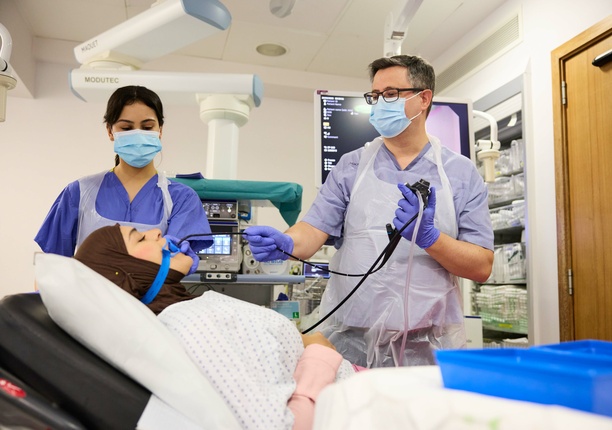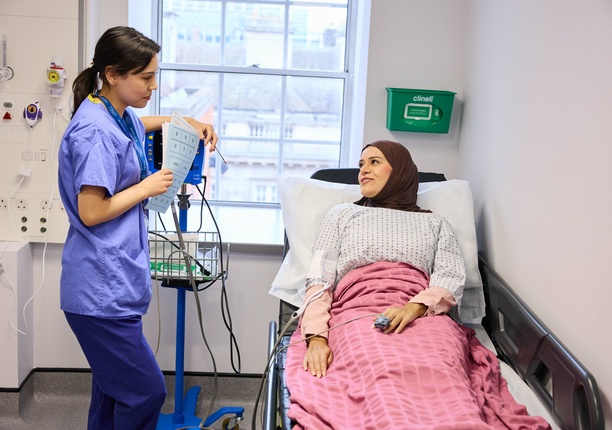Endobronchial ultrasound (EBUS)
An endobronchial ultrasound (EBUS) is an advanced diagnostic method which provides a precise, real-time assessment of the lungs, lymph nodes and surrounding structures.
At The London Clinic Lung Centre, our expertise in EBUS ensures world-class diagnostic accuracy.
What is an EBUS?
EBUS is a minimally invasive diagnostic procedure that uses ultrasound technology to enable a specialist to visualise and sample structures within and around the lungs.
Performed with a specialised bronchoscope equipped with an ultrasound probe and needle, this procedure allows your specialist to collect tissue samples and assess your lungs for abnormalities. The combination of visualisation and tissue samples helps in diagnosing and monitoring conditions such as lung cancer, infections (such as tuberculosis), inflammatory conditions (such as sarcoidosis) and lymphadenopathy.
EBUS can also diagnose hard-to-reach tumours, including ones located next to the bronchus (the airway between the lung and windpipe).
Having an EBUS speeds up diagnosis, allowing your specialist to begin treatment sooner.
Are there any risks associated with EBUS?
EBUS is generally considered a very safe procedure. As such, serious complications are uncommon when an EBUS is performed by an experienced specialist.
However, there are some potential complications to be aware of:
- Bleeding – if you’ve had an EBUS with biopsy, minor bleeding is possible. However, it usually resolves without intervention
- Infection – there is a low risk of infection in the lungs or mediastinum due to a biopsy procedure
- Pneumothorax (collapsed lung) – this is an extremely rare complication, but it can occur if the lung is inadvertently punctured during needle aspiration
- Sore throat or hoarseness – you can experience temporary irritation of the throat or vocal cords from the bronchoscope
- Sedation-related complications – you may experience side effects, such as dizziness or nausea. Rarely, sedatives can cause an allergic reaction
- Discomfort or coughing – mild and temporary discomfort may occur during or after the procedure
- Failed procedure – in rare cases, when an EBUS biopsy is required, insufficient tissue may be collected, meaning the bronchoscopy procedure may need to be repeated
EBUS FAQs
At The London Clinic Lung Centre, an EBUS is a same-day procedure that normally takes around 45 minutes.
Step 1. Preparing for your EBUS
Prior to your EBUS, you will receive instructions on how to prepare. Here’s what you can expect:
- Fasting – you will be asked to avoid eating for several hours before the EBUS procedure
- Medical history – your doctor will review your medical history and explain the procedure, including any sedation or anaesthesia involved
- Ask someone to collect you – if receiving sedation, you may feel drowsy after the procedure and be unable to drive yourself home
Just before you have your scan, a technologist will explain the EBUS procedure, give you an opportunity to ask any questions and go through a checklist of questions.
Step 2. During your EBUS
Before the procedure begins, your specialist will offer you medication to help you sleep and relax. They will also apply a local anaesthetic spray to numb your vocal cords and windpipe, ensuring you feel more comfortable.
To begin the procedure, your specialist will gently insert the bronchoscope into your lungs or upper digestive system through your mouth and windpipe. Real-time, high-quality imaging will enable your specialist to examine your lungs and nearby lymph nodes. If necessary, they will also take a small tissue sample (biopsy).
Step 3. Recovery and aftercare
After the procedure, your care team will take you to the recovery suite, where they will safely monitor you as you wake up. You will not be able to eat or drink for one hour following the procedure, as your throat will still be numb from the anaesthetic. You must not drive or operate machinery for 24 hours.
As an EBUS is a minimally invasive procedure, most people return to normal after 24 hours. Many find they can resume work and normal activities soon after the procedure.
Once you are ready to leave, we will provide advice to ensure a safe recovery at home. If you need transportation home after the procedure, we can arrange a taxi for you.




